Your cart is currently empty!
Home / Garden Blog / How to Handle Slugs, Budworm and Other Common Garden Pests
How to Handle Slugs, Budworm and Other Common Garden Pests
-
Susan Martin
Let’s face it—if you are going to grow a garden, eventually you are going to encounter insects. After all, they are a natural part of a living ecosystem. Birds rely on insects to feed their young, and in fact, many beneficial insects rely on other insects for survival. Most are completely harmless and don’t warrant any human intervention or control. Often, a healthy ecosystem will keep itself in balance and not let any one pest dominate.
We can overlook a moderate number of holes in leaves or missing blooms. However, there are times when our patience is tested to the limit with pests. A particularly harmful pest may move into the area and require control, or a pest that doesn’t usually cause much harm may multiply too rapidly and start to decimate a plant. In some cases, we need to step in to help nature get back into balance.
The goal of this article is to give you a top level view of some common garden pests. If you’d like to dig deeper into the topic, we suggest studying this comprehensive article.
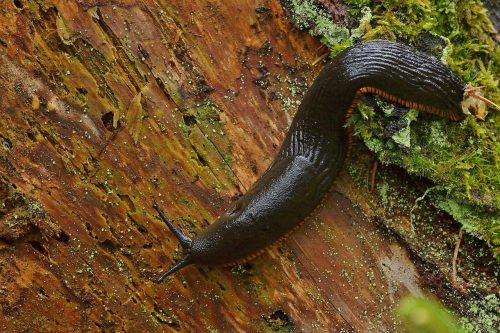
Common Garden Pests: Slugs and Snails
There are countless types of slugs and snails in the world, all of which might make your skin crawl as they slither through your garden. For this general discussion, we’ll tell you about the types of slugs and snails that we encounter most often in our gardens. They are usually less than two inches in size and are found in the garden from late spring through fall. The later in the season, the bigger they’ve grown.
Slugs and snails live off decaying organic matter like fallen leaves, bark and flower petals. They’ll also march right up the petioles of your hosta leaves and munch there too, feeding at night or on rainy, overcast days when their soft bodies will be protected from the sun’s drying rays. They chew irregular holes in leaves and flowers, leaving behind a shiny, silvery trail of their mucus as they go.
Slugs and snails are easy to catch and kill with baits and traps. Organic products like Sluggo are readily available and are safe to use around pets and edible plants. Sinking a tin can filled with beer, soapy water or a sugar-yeast mixture in the ground will also catch slugs that are in the area. Leaving a wet board or hollowed out orange rind on the ground also works. Handpicking is an option for the brave at heart, but sprinkling crushed egg shells around your plants isn’t very effective. You could let birds do the work for you. Encourage more birds to take up residence in your garden and they will help to keep the slug and snail populations in check for you.

Petunia Budworm
If your petunia’s flowers have gone missing overnight, you might have petunia budworm. It also goes by the names geranium budworm and tobacco budworm since it can affect those plants, too. In fact, it has been known to feed on numerous other plants including roses, ageratum, chrysanthemums, snapdragons, strawflowers and more.
Look for caterpillars that are about 1 to 1.5 inches long and either brown, green or reddish. You might also see black spots on the leaves which is their poop. They turn into gray-brown moths which lay eggs on the flower buds at night and hatch within a week. Multiple generations are possible each season.
A natural bacteria called Bacillus thuringiensis, or Bt for short, is effective at treating petunia budworm, but it is less effective for geraniums and tobacco. Pyrethroid insecticides may be necessary for the latter. Monitor your plants carefully for these common garden pests and spray at the first sign of their eggs hatching.
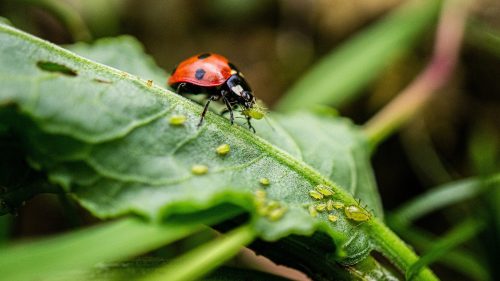
Aphids
The sight of aphids on plants can be alarming simply because when you see one, you usually see many more all clustered together on a plant’s stem. This insect multiplies very rapidly and they tend to stick together on the plant, whereas many other insects split up and disburse out into the garden once they have hatched. Where you see aphids, hopefully you will also spot a few ladybugs nearby getting ready to have their lunch. They are voracious aphid eaters.
Aphids are sucking insects, so you may notice crinkled or distorted leaves or flowers on your plant before you spot the pests. Some plants such as false sunflowers, true sunflowers, milkweed, dahlias and roses are often targeted by aphids. In large numbers, the pest can weaken a plant over time.
A strong stream of water repeated every few days may be all you need to knock these common garden pests off of your plants. If that doesn’t work, neem oil, insecticidal soap or horticultural oil are effective at controlling these soft-bodied pests.
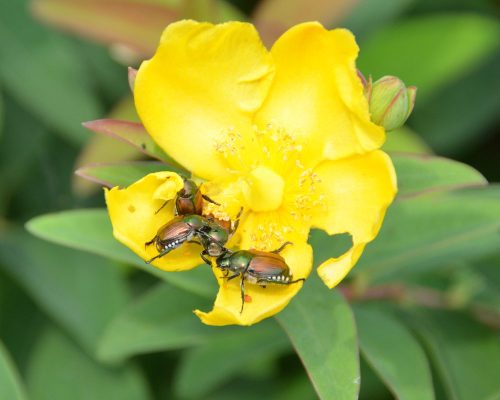
Japanese Beetles
In some parts of the country, Japanese beetles are voracious pests that feed on many different types of annuals, perennials, trees and shrubs in the summertime. They are particularly fond of plants in the Rosaceae family which includes popular garden plants like roses, spirea, potentilla, ninebark, strawberries, cherries, apples, serviceberries and many other fruit trees.
Their shiny copper and green bodies make them easy to spot as they brazenly feed out in the open in the daytime. A hard shell protects their bodies like armor, which makes them difficult to control with insecticides. They can fly in from neighboring yards and fields so even if you take measures to control them in your yard, you may still have Japanese beetles to contend with.
Because of their hard shell, it is more effective to treat for these common garden pests when it is in grub stage before the beetles hatch. The grubs are present in the ground from fall through spring before they hatch into beetles which emerge in early to midsummer to feed in your garden. Chemical treatments such as GrubEx and Grub Killer are readily available. A more natural method is using milky spore bacteria applied to your lawn in the summer or early fall. Japanese beetle grubs must ingest the bacteria for it to kill them, and it can take a few years for the bacteria to multiply enough in the soil for it to become an effective treatment.
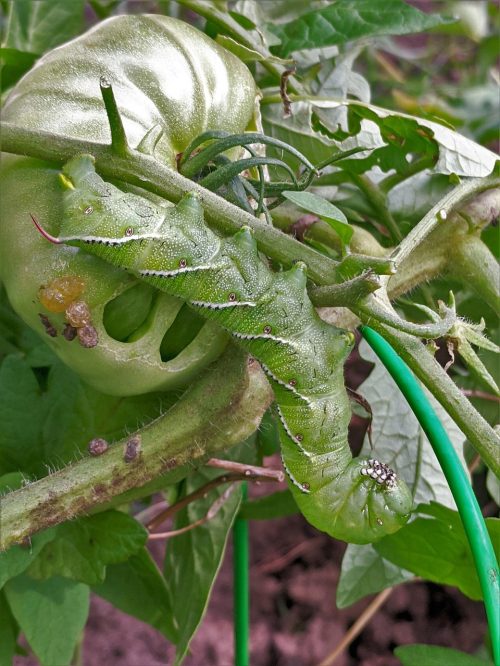
Tomato and Tobacco Hornworms
You’ll find these two types of hornworms feeding on your tomato, pepper, eggplant and potato plants in the summertime. Both are easy to spot since they are quite large and plump, easily reaching 4 inches long. They are light green in color with white stripes on their back and a horn on their backside. You’ll find them hanging out under the leaves of your veggie plants, blending in with their camouflaged green bodies. They like to eat both leaves and fruit, and they will chew large holes in both.
The easiest way to manage hornworms is to pick them off and drop them into a bucket of soapy water. If you have chickens, hornworms are a special treat for them. As described under the budworm section above, the natural bacteria Bt is also effective on hornworms, as is insecticidal soap. If you see a hornworm with strange white protrusions sticking out of it, leave it be. Such a hornworm has been infected by a parasitizing beneficial wasp, and the baby wasps that hatch as a result will help you combat more hornworms in the future.
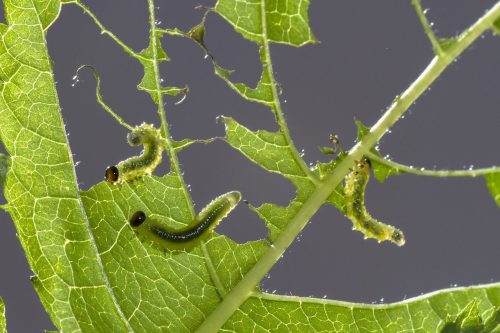
Sawfly Larvae
If the leaves of your perennial hibiscus quickly become skeletonized each year in early to midsummer, sawfly larvae may be to blame. Japanese beetles are often thought to be the problem, but usually by the time they have entered the picture, your plants have already been damaged by sawfly larvae. Then, Japanese beetles move in to munch on the flowers when they open in mid to late summer.
Sawfly larvae are misunderstood, not in small part because of their name. This pest is neither a fly nor a caterpillar. It is, in fact, more closely related to wasps and bees but it is not a pollinator. The larvae look similar to small, hairless caterpillars. They develop into a wasp-like insect that looks a bit like a large fly and it lacks the ability to sting.
Sawfly larvae are plant eaters that often feed in groups and can quickly defoliate portions of the plant they are feeding on. They feed for about 4 to 6 weeks in early to midsummer which is when you’ll notice the most damage occurring. They will eat all the fleshy parts of the leaf, leaving the tougher midrib and veins for the next pest to come along. If this only happens once or twice to a plant and the damage isn’t too severe, it won’t be harmed. But if it happens every year, it’s time to take steps to control the pest.
You’ll need to keep an eye out for this pest beginning in the spring. Pesticides are usually only effective when sawfly larvae is young. Because they are not a true caterpillar, the natural Bt treatment you might be using for your petunia budworm or tomato hornworm won’t work for sawfly larvae. Instead, try insecticidal soap, horticultural oil or Spinosad. Systemic insecticides should be a last resort as they can harm pollinators that are feeding on plants nearby.
Want to learn more?
- Categories: Uncategorized
Recent Posts
- How to Grow and Maintain Young Shrubs March 24, 2025
- Pruning Evergreens March 5, 2025
- 7 Questions to Ask Yourself Before Starting a New Garden February 18, 2025
Categories
- Annual Flowers
- Butterfly House
- Container Gardening
- Cultural Care
- Flowering Clematis Vines
- Flowering Shrubs
- Garden Crossings Garden Center
- Garden Perennials
- Heidi's Plant Picks
- House Plants
- Landscape Plantings
- New Plant Varieties
- Press Releases
- Seasonal Gardening Planner
- Succulents
- Uncategorized
- What's Blooming
